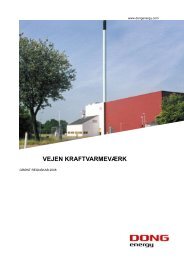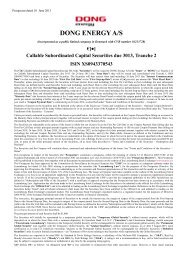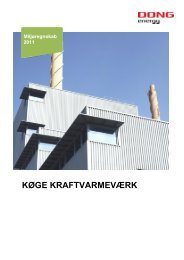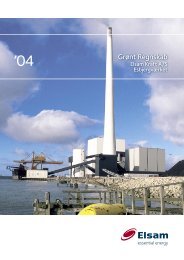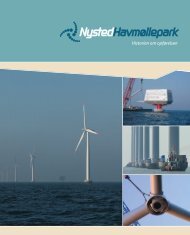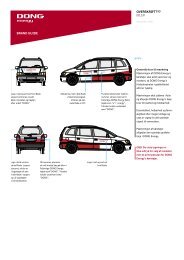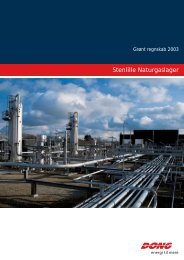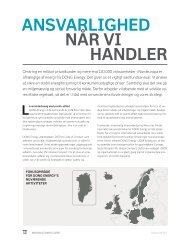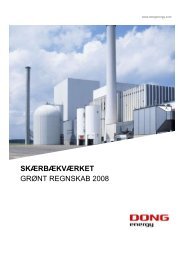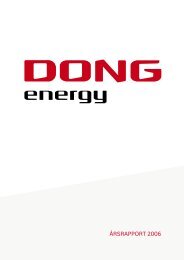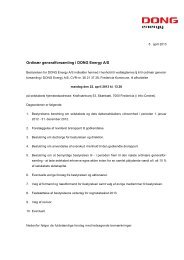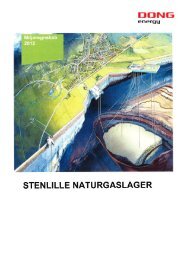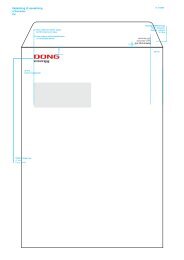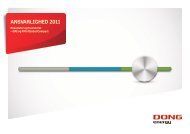ANNUAL REPORT 2011 - DONG Energy
ANNUAL REPORT 2011 - DONG Energy
ANNUAL REPORT 2011 - DONG Energy
Create successful ePaper yourself
Turn your PDF publications into a flip-book with our unique Google optimized e-Paper software.
notes<br />
40 Description of accounting policies<br />
plant and equipment are determined as the selling price less<br />
costs to sell and the carrying amount at the date of disposal.<br />
Government grants<br />
Government grants comprise grants for eco-friendly generation<br />
and grants for and funding of research and development projects.<br />
Government grants are recognised when there is reasonable<br />
assurance that they will be received.<br />
Grants for electricity generation are recognised as revenue as<br />
the related electricity revenue is recognised.<br />
Grants for research and development costs, which are recognised<br />
directly in profit for the year, are recognised as other<br />
operating income as the costs to which the grants relate are<br />
incurred.<br />
Grants for production assets and development projects are<br />
recognised in the balance sheet as liabilities and transferred<br />
to other operating income in profit for the year as the assets to<br />
which the grants relate are depreciated.<br />
Allocated CO 2 emissions allowances are recognised as rights<br />
within intangible assets. Reference is made to the description<br />
of the accounting policies under the relevant sections.<br />
share of profit (loss) of associates<br />
The proportionate share of associates’ profit after tax and noncontrolling<br />
interests and after elimination of the proportionate<br />
share of intragroup profits/losses is recognised in profit for the<br />
year.<br />
finance income and costs<br />
Finance income and costs comprise interest income and expense,<br />
capital gains and losses and impairment losses relating<br />
to securities, payables and transactions denominated in foreign<br />
currencies, amortisation of financial assets and liabilities,<br />
including lease commitments under finance leases, as well as<br />
surcharges and refunds under the on-account tax scheme, etc.<br />
Finance income and costs also include realised and unrealised<br />
gains and losses relating to hedging of interest rate and currency<br />
risks that have not been entered into to hedge revenue,<br />
fuel and energy or non-current assets. Interest is recognised<br />
under the accrual basis of accounting. Dividends from other<br />
equity investments are recognised as they are received.<br />
Borrowing costs relating to general borrowing or loans directly<br />
attributable to the acquisition, construction or development of<br />
qualifying assets form part of the cost of such assets.<br />
136 COnsOliDatED finanCial statEmEnts – <strong>DONG</strong> ENERGY <strong>ANNUAL</strong> <strong>REPORT</strong> <strong>2011</strong><br />
income tax expense<br />
The Group is subject to the Danish rules on compulsory joint<br />
taxation and has also elected international joint taxation with<br />
the Group’s foreign subsidiaries. The Group’s subsidiaries are<br />
included in the joint taxation from the date they are included<br />
in the consolidation in the consolidated financial statements<br />
and up to the date on which they are no longer included in the<br />
consolidation.<br />
The current Danish income tax is allocated among the jointly<br />
taxed Danish subsidiaries in proportion to their taxable income.<br />
In this connection Danish subsidiaries with tax losses<br />
receive joint taxation contributions from the parent company<br />
equivalent to the tax base of the tax losses utilised (full allocation),<br />
while companies that utilise tax losses in other Danish<br />
companies pay joint taxation contributions to the parent company<br />
equivalent to the tax base of the utilised losses.<br />
Income tax expense, which consists of current tax, joint taxation<br />
contribution for the year and changes in deferred tax, is<br />
recognised in profit for the year to the extent that it relates to<br />
profit for the year, and directly in other comprehensive income<br />
to the extent that it relates to entries directly to other comprehensive<br />
income.<br />
The Group is registered for the Danish on-account tax scheme.<br />
Tax refunds/tax surcharges are allocated between the jointly<br />
taxed Danish companies in accordance with the allocation of<br />
the Danish income tax and recognised as finance income and<br />
finance costs respectively.<br />
Subsidiaries that are engaged in oil and gas recovery (hydrocarbons)<br />
are subject to the hydrocarbon tax legislation in the<br />
countries in which they operate. Hydrocarbon taxes are calculated<br />
on the basis of taxable hydrocarbon income and comprise<br />
taxes calculated applying the respective country’s ordinary<br />
income tax rate as well as taxes calculated applying increased<br />
tax rates. Hydrocarbon taxes are recognised within income tax<br />
expense.<br />
intangible assets<br />
Goodwill<br />
Goodwill is recognised initially in the balance sheet at cost as<br />
described under business combinations. Subsequent to initial<br />
recognition, goodwill is measured at cost less accumulated<br />
impairment losses. Goodwill is not amortised. The carrying<br />
amount of goodwill is allocated to the Group’s cash-generating<br />
units at the acquisition date. The determination of cash-generating<br />
units follows the Group’s organisational and internal<br />
reporting structure.



